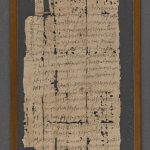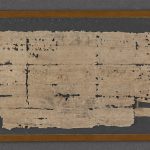| Artefact ID | 185 |
| TM ID | TM 10058 |
| Findspot (DEChriM ID) | 50 (Qaṣr Qārūn) | Class | Textual |
| Material | Papyrus |
| Writing medium | Sheet/roll |
| Text content | Documentary |
| Language | Greek |
| Archive/Dossier | Archive |
| Description | P.Abinn. 7; P.Lond. II 418: Letter from Apa Mios to Abinnaeus. One of the three letters sent by Apa Mios (P. Abinn. 6, 7, 8, and probably P. Abinn. 19) to his "beloved and truly a brother" Abinnaeus ([τῷ] ἀγαπητῶ καὶ ἀληθο͂ς ἀδ[ε]λ[φ]ῷ). Mios, who has been attempting to find Abinnaeus to discuss an urgent matter, in which a priest and various deliveries in kind are involved, writes to ask for a meeting. On the question whether Abinnaeus, commander of the cavalry (praefectus alae) in Dionysias, was a Christian and for his relationship with monks and clergy, see Barnes 1985: 373-374, Choat 2006: passim, Luijendijk 2008: 35, n. 42, Kaiser 2015: 383, Choat 2017: 47.
Recto: Irregular cursive hand; use of nomina sacra; text along the fibres with one line written in the left margin perpendicularly to the main text (greetings to Abinnaeus’ household). Verso: address, along the fibres. |
| Selection criteria | Mention of Christian cult officials/institutions, Christian terms/formulas/concepts, Nomina sacra |
| Date from | 342 |
| Date to | 351 |
| Dating criteria | Dated to ca. 346 in ed. pr. According to Gallazzi (2015: 177-178), all of the dated texts of Abinnaeus archive are dated between 343 and 351 AD, that is, in the period in which Abinnaeus exercised his functions of praepositus of the castra (342-351). |
| Absolute/relative date | Relative date |
| Archaeological context | Purchased as part of a lot comprising Papyri 401-447 from the Reverend Chauncey Murch (b. 1856, d. 1907) on 15 May 1893 (British Library). While it was previously thought that Fl. Abinnaeus' archive was found in Philadelpheia where he went to live after his retirement, Gallazzi 2015 argued that Fl. Abinnaeus should have left his papers in his office (or in his lodgings), in Dionysias, when he left the army and handed over the command of the castra to others. The material would have been recovered in Qaṣr Qārūn, at the end of the nineteenth century, by antiquities seekers or sebâkh quarrymen and given to merchants of Medînet el-Fayûm, where they would have been intermingled with the documents recovered at Kharabet el-Gerza (Philadelphia), before reaching European collections. |
| Accession number | London, British Library, Pap 418 |
ARTEFACT IDENTIFIERS
Publications
· Bell, Harold Idris, Victor Martin, Eric G. Turner and Denis van Berchem, 1962. The Abinnaeus Archive. Papers of a Roman Officer in the Reign of Constantius II. Oxford: Clarendon Press, 46-48, no. 7
· Kenyon, Frederic G. 1898. Greek Papyri in the British Museum II. London: British Museum, 302-303, no. 418.
· Tibiletti, Giuseppe. 1979. Le lettere private nei papiri greci del III e IV secolo d.C.: tra paganesimo e cristianesimo. Milano: Vita e Pensiero, no. 25.
Other studies
· Barnes, Timothy D. 1985. “The Career of Abinnaeus.” Phoenix 39, 368-374.
· Choat, Malcolm. 2006. Belief and Cult in Fourth-Century Papyri. Studia Antiqua Australiensia 1. Turnhout: Brepols.
· Choat, Malcolm and Maria Chiara Giorda. 2017. Writing and Communication in Early Monasticism. Texts and Studies in Eastern Christianity 9. Leiden-Boston.
· Gallazzi, Claudio. 2015. “Dove è stato ritrovato l’archivio di Abinneo?” Archiv für Papyrusforschung und verwandte Gebiete 61, 170-179.
· Kaiser, Anna Maria. 2012. “Die Fahndung nach Deserteuren im spätantiken Ägypten.” In Actes du 26e Congrès international de papyrologie, Genève 16-21 août 2010, ed. Paul Schubert. Genève: Droz, 381-390.
· Luijendijk, AnneMarie. 2008. Greetings in the Lord: early Christians and the Oxyrhynchus papyri. Cambridge, Mass.-London: Harvard University Press.


 Json data
Json data





